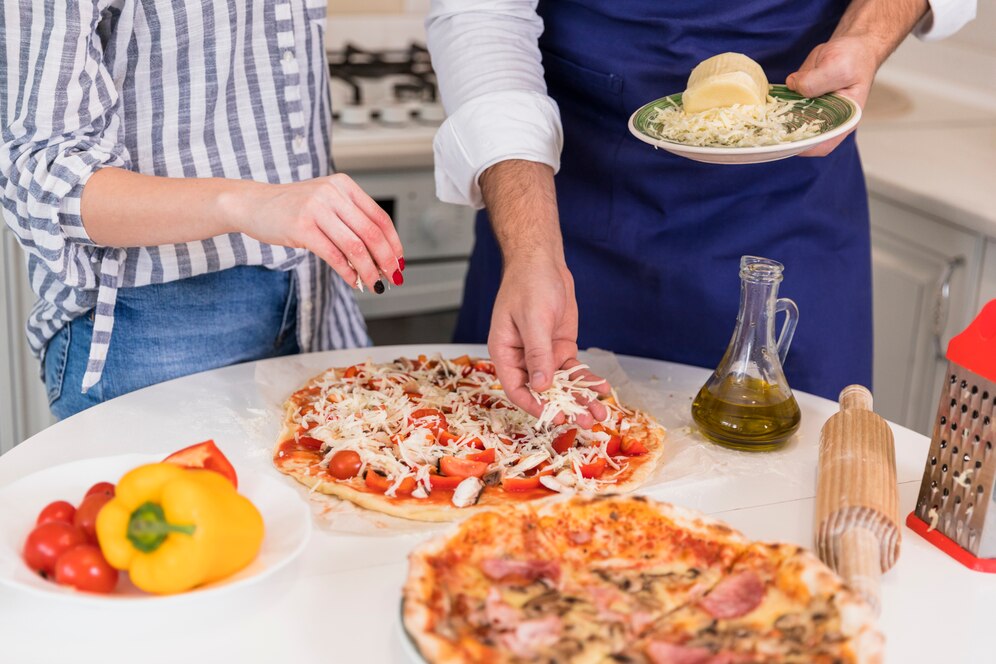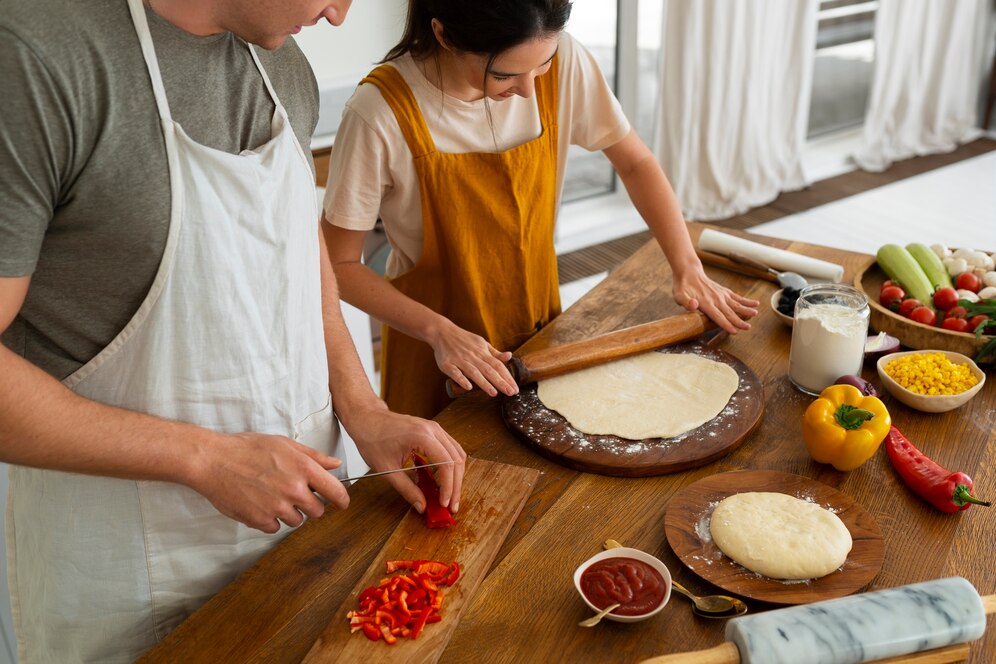How to Make the Perfect Homemade Pizza
Our team has found that mastering homemade pizza requires ingredients, techniques, and a passion for the craft. Pizza is more than just a meal—it’s a universal comfort food that brings people together. While ordering from your favourite pizzeria is convenient, there’s something truly rewarding about crafting your pizza from scratch. Our team has found that

Our team has found that mastering homemade pizza requires ingredients, techniques, and a passion for the craft.
Pizza is more than just a meal—it’s a universal comfort food that brings people together. While ordering from your favourite pizzeria is convenient, there’s something truly rewarding about crafting your pizza from scratch. Our team has found that perfecting this classic dish involves more than dough, sauce, and cheese. By following essential techniques and selecting quality ingredients, you can create a restaurant-quality pizza in your kitchen.
We have performed extensive tests and research to identify the best strategies for achieving the perfect crust, flavorful sauce, and ideal cheese melt. The results consistently show that a well-balanced combination of technique, timing, and ingredient selection can transform homemade pizza into a gourmet experience. You can make the perfect pizza every time by incorporating these elements into your preparation.
The benefits of homemade pizza extend beyond just taste. Making your pizza allows you to control ingredient quality, customise flavours, and create healthier alternatives to store-bought or restaurant versions. Following the strategies outlined in this guide, you can master the art of pizza-making and elevate your culinary skills.
Pro Tip: Use a pizza stone or steel to mimic the high heat of a professional pizza oven and achieve the perfect crispy crust.
Quick Guide: Crafting the Perfect Homemade Pizza

- Choose high-quality ingredients—flour, yeast, fresh tomatoes, and premium cheeses.
- Allow dough to ferment for enhanced flavour and texture.
- Preheat the oven to the highest temperature for a crispy crust.
- Use fresh mozzarella and a balanced tomato sauce.
- Experiment with toppings, but avoid overloading the pizza.
- Use a pizza stone or steel for even heat distribution.
Important: Patience is key—rushing the fermentation process or baking at low temperatures can lead to a dense or soggy pizza.
Understanding the Importance of Technique
Achieving the perfect pizza isn’t just about assembling ingredients—it requires precision and attention to detail. The proper technique balances a crispy, golden crust and a perfectly melted, flavorful topping combination.
Our team has identified that consistency is key. Using the same fermentation time, temperature settings, and ingredient proportions each time leads to predictable, high-quality results. Rushing the dough process or using cold ingredients can result in a chewy or undercooked crust.
Creating the right baking environment is essential. Preheating the oven to at least 250°C (480°F) allows the crust to develop the perfect texture. Pizza stone or steel ensures even heat distribution and prevents a soggy centre. Placing the pizza on a preheated surface also helps achieve a pizzeria-style crispiness.
By making intentional choices about dough hydration, sauce thickness, and cheese distribution, you can craft a pizza that is visually appealing and deliciously satisfying.
How to Optimize Your Homemade Pizza for Maximum Flavor

1. Choosing the Right Dough and Fermentation Method
The foundation of a great pizza starts with selecting the best flour and allowing the dough to develop flavour through fermentation. Options like all-purpose flour, bread flour, or the highly recommended ‘00’ flour impact the final texture.
- Cold Fermentation: Letting the dough rest in the fridge for 24-48 hours enhances its flavour and texture.
- Room-Temperature Fermentation: Allowing the dough to rise at room temperature for 2-3 hours speeds up the process but results in a slightly less complex flavour.
- Hydration Levels: A dough hydration level of 60-65% (ratio of water to flour) is ideal for a balance between crispiness and chewiness.
2. Crafting the Perfect Pizza Sauce
An excellent pizza sauce is simple yet flavorful. Avoid overcooking the sauce to preserve the fresh, vibrant taste of tomatoes.
- Use high-quality canned tomatoes, such as San Marzano, for authentic flavour.
- Blend tomatoes with olive oil, salt, garlic, and oregano.
- Simmer briefly to reduce excess water but retain fresh tomato essence.
- Avoid over-saucing to prevent a soggy crust.
3. Selecting the Best Cheese for Melting and Flavor
Cheese is the heart of any pizza; choosing the right type affects texture and taste.
- Fresh Mozzarella: Creamy and traditional but releases moisture.
- Low-Moisture Mozzarella: Ideal for a stringy, gooey melt.
- Parmesan & Pecorino: Add depth and umami flavour.
- Provolone & Gouda: Provide extra creaminess and complexity.
4. Mastering the Baking Process
- Preheat oven for at least 30 minutes before baking.
- Use a pizza stone or steel to achieve high-heat consistency.
- Bake at 250°C (480°F) or higher for a crisp, airy crust.
- Rotate the pizza halfway through to ensure even cooking.
Advanced Tips for a Next-Level Homemade Pizza
- Brush crust with olive oil: This enhances browning and adds extra flavour.
- Par-bake the crust: Pre-baking for 2-3 minutes prevents sogginess with heavy toppings.
- Sprinkle semolina or cornmeal on the baking surface to prevent sticking.
- Use fresh herbs after baking: Basil, arugula, or oregano adds a fresh kick.
- Drizzle with flavoured oils: Truffle, garlic-infused, or chilli oil can elevate flavours.
Frequently Asked Questions About Homemade Pizza

What is the best flour for pizza dough?
‘00’ flour is ideal for a light, airy texture, but bread flour works well for a slightly chewier crust.
How long should I let pizza dough ferment?
Fermenting the dough in the fridge for 24-48 hours enhances its taste and texture for the best flavour.
How do I prevent my pizza from being soggy?
Avoid excess sauce, use a preheated baking surface, and bake at high temperatures for a crisp crust.
Can I use store-bought dough?
Yes, but homemade dough offers superior texture and flavour. If using store-bought dough, allow it to rest at room temperature before stretching.
What’s the best way to reheat pizza?
Reheat in a 200°C (400°F) oven for 5-7 minutes or in a skillet over medium heat for a crispy bottom.
How do I get a pizzeria-style crust at home?
A pizza stone, baking steel, or an outdoor pizza oven can help achieve high-heat baking for an authentic crust.
What are some creative topping combinations?
Try fig and prosciutto, BBQ chicken with red onion, or truffle mushroom with ricotta for gourmet flavours.